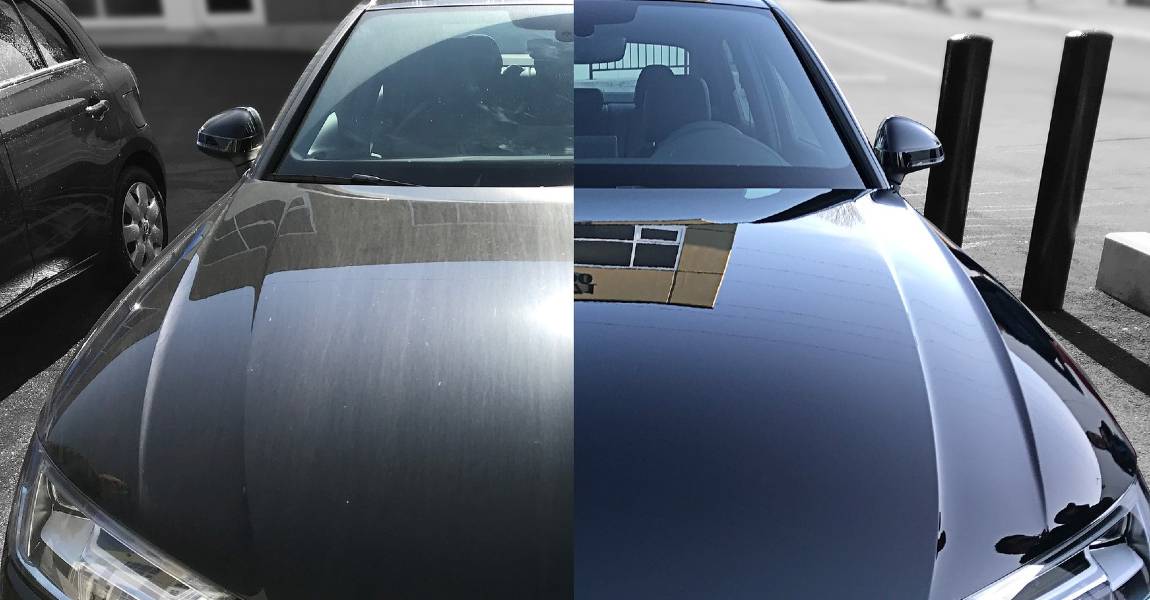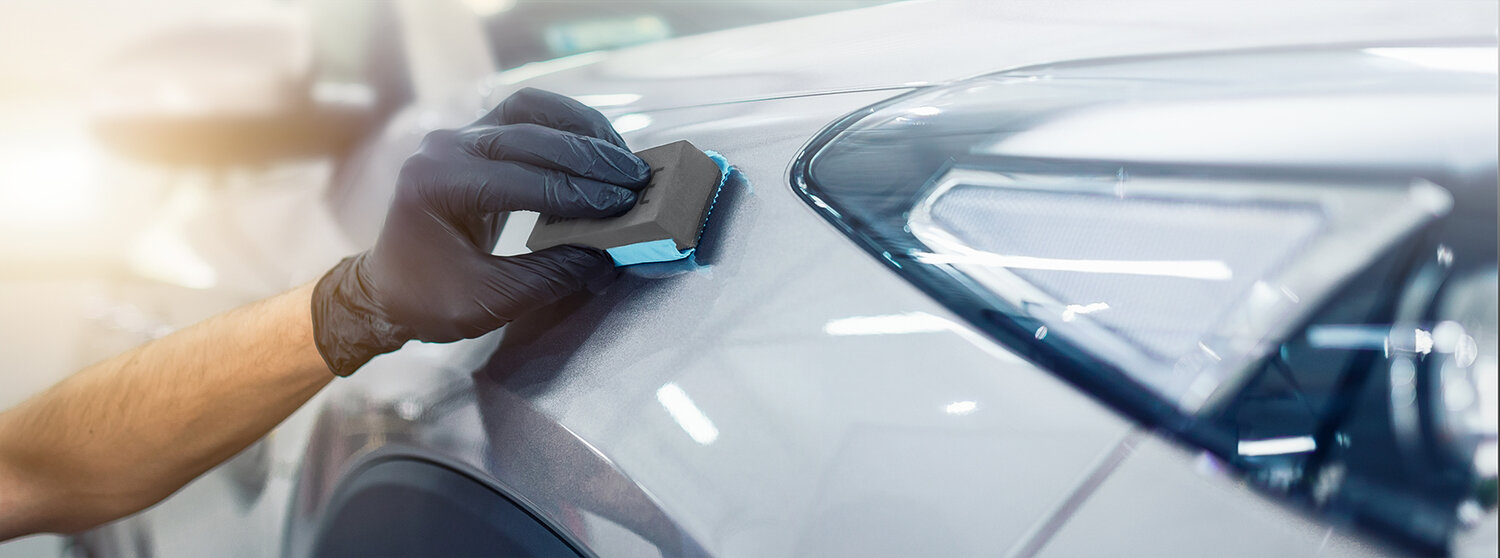Ceramic Coating vs. Conventional Wax: Which One Offers Superior Defense?
Ceramic Coating vs. Conventional Wax: Which One Offers Superior Defense?
Blog Article
Recognizing the Science Behind Ceramic Coating for Improved Lorry Sturdiness
The scientific research of ceramic finish is transforming vehicle maintenance by providing a powerful shield versus severe environmental variables. At its core, this modern technology uses the power of silicon dioxide and titanium dioxide to form a sturdy, safety layer. However exactly what makes these substances so reliable in protecting an automobile's exterior? As we explore the elaborate make-up and application procedure of ceramic layers, we uncover the secrets behind their remarkable defense and long life. How does this contrast to typical approaches, and what implications does it have for automobile maintenance in the long-term? The solutions might stun you.

Make-up of Ceramic Coatings
Ceramic layers are mostly made up of silicon dioxide (SiO2), which is stemmed from natural products like quartz and sand. This compound forms the foundation of the covering, giving its characteristic solidity and resistance to environmental elements. In addition to SiO2, ceramic layers typically incorporate titanium dioxide (TiO2) for improved UV security and raised resistance to environmental contaminants. These nanocomposite products create a robust, chemical bond with the automobile's surface area, offering a long-lasting protective layer.
The formula of ceramic finishings is a thorough process where the concentration of SiO2 can considerably affect the finish's efficiency. Higher SiO2 material generally leads to higher toughness and hardness, adding to the finish's capability to stand up to scratches and chemical etching. Nevertheless, the balance of elements is essential; excessive SiO2 can make the coating breakable, while insufficient can endanger its protective residential properties.
Producers might additionally integrate additional compounds, such as polysilazane, to improve versatility and convenience of application. These ingredients boost the finishing's hydrophobic residential or commercial properties, guaranteeing water and contaminants grain off the surface effortlessly. This engineered composition underscores the efficacy of ceramic finishes in securing a lorry's outside versus a variety of adverse problems.
Application Process Described
Using a ceramic coating to a lorry includes several critical steps, each necessary to guaranteeing optimum adhesion and efficiency of the safety layer - ceramic coating. The procedure begins with an extensive clean and decontamination of the car's surface to eliminate dirt, crud, and previous waxes or sealants. This action is critical as any kind of impurities left externally can impede the finishing's capacity to bond effectively
Adhering to the preliminary cleansing, the next action involves brightening the automobile to eliminate any kind of imperfections, such as swirl marks or scratches. Polishing makes certain a smooth surface area, which is essential for the finishing to stick properly and supply a consistent finish. After brightening, a surface area preparation spray is made use of to remove any kind of staying deposits and make certain that the surface area is entirely clean.

Safety Benefits
Typically hailed for its outstanding safety high qualities, a ceramic covering provides numerous benefits that substantially enhance car resilience. At its core, ceramic finishing develops a hard, click here now semi-permanent obstacle over a lorry's exterior, which functions as a guard against different ecological dangers. This advanced layer of security properly safeguards against UV rays, oxidation, and fading, maintaining the vehicle's initial paint and shine. It lessens the threats presented by harmful he said impurities such as bird droppings, tree sap, and road gunk, which, if left unattended, can lead to permanent damages.
Furthermore, ceramic finishes exhibit hydrophobic homes, indicating they drive away water and help with a self-cleaning result. This quality decreases the adherence of dirt and mud, simplifying upkeep and cleansing processes. The finish's resistance to chemical etching even more ensures that the car's surface area stays unblemished in spite of direct exposure to harsh cleaner and pollutants.
Along with these safety advantages, the ceramic layer enhances an automobile's visual appeal by producing a shiny coating that highlights color deepness and clearness. This not only sustains the car's visual allure but likewise adds to its long-term value by preserving the integrity of its outside with time.
Comparing to Typical Methods
Unlike standard approaches of vehicle security, such as shaving or sealers, ceramic coatings use a more lasting and sturdy option. Where waxes and sealants normally provide a short-term layer of protection, typically calling for reapplication every couple of months, ceramic coverings develop a semi-permanent bond with the lorry's paint. This bond produces a safety layer that is resistant to environmental contaminants, UV damage, and small abrasions.
Typical waxes are mostly composed of natural elements like carnauba wax, supplying a glossy coating but lacking the durable safety qualities of ceramic coverings. Sealers, while artificial and offering slightly much better longevity than waxes, still drop brief in contrast to the strength and chemical resistance of ceramic coatings. The advanced technology of ceramic coatings includes nanotechnology, which permits them to complete microscopic flaws in the paint surface area, causing a smoother and much more hydrophobic surface.
In regards to application, ceramic coatings need an even more meticulous procedure, typically requiring specialist installment to make sure optimal performance. This contrasts with the fairly uncomplicated application of waxes and sealers, which can be applied at home. Nevertheless, the premium security and aesthetic improvement provided by ceramic finishes warrant the financial investment for those seeking long-term car conservation.
Long Life and Maintenance
How does the durability of ceramic coatings equate into ease of upkeep for lorry proprietors? The sophisticated formulation of ceramic finishes provides a durable safety layer on the automobile's surface, which substantially prolongs the lifespan of the automobile's exterior coating. This durability implies that go to my site the finishing acts as a guard against ecological pollutants such as UV rays, bird droppings, and roadway grime, which can or else weaken paintwork gradually. Therefore, vehicles covered with ceramic products call for much less constant cleaning and detailing efforts, thereby lowering upkeep time and costs for proprietors.
Furthermore, the hydrophobic nature of ceramic coverings makes it possible for water and various other liquids to bead up and roll off the surface area, carrying dirt and debris with them. While the finish itself is lasting, it is not completely maintenance-free. Therefore, ceramic coatings offer a useful equilibrium between long-lasting durability and streamlined upkeep for vehicle treatment.
Verdict
Ceramic finishings, with their advanced chemical composition of silicon dioxide and titanium dioxide, provide a powerful barrier versus environmental damages, dramatically enhancing car longevity. When compared to traditional methods, ceramic coatings supply premium defense versus UV rays, oxidation, and chemical etching - ceramic coating.
The formulation of ceramic layers is a meticulous procedure where the focus of SiO2 can considerably affect the finish's performance.Using a ceramic covering to an automobile entails several critical actions, each vital to making sure optimal attachment and performance of the safety layer.Typically hailed for its phenomenal safety qualities, a ceramic layer provides various benefits that significantly improve vehicle resilience. The advanced formula of ceramic coatings gives a robust protective layer on the vehicle's surface area, which dramatically prolongs the life-span of the auto's outside surface.Ceramic coatings, with their sophisticated chemical composition of silicon dioxide and titanium dioxide, offer a powerful obstacle versus ecological damage, considerably boosting lorry resilience.
Report this page